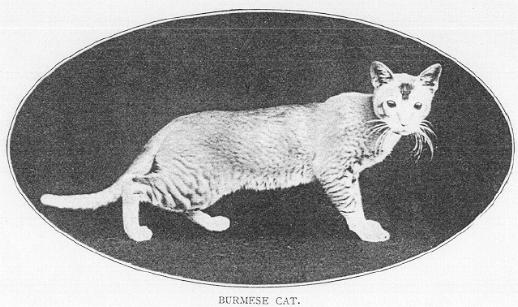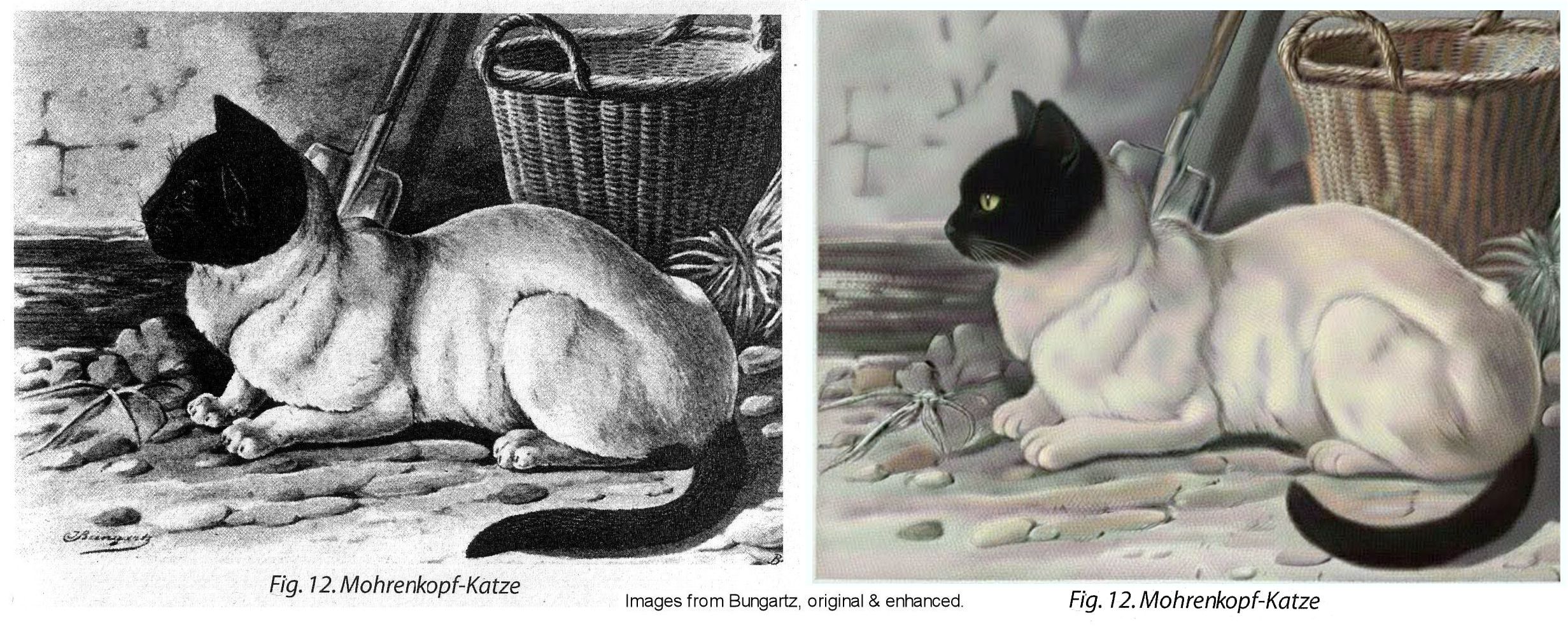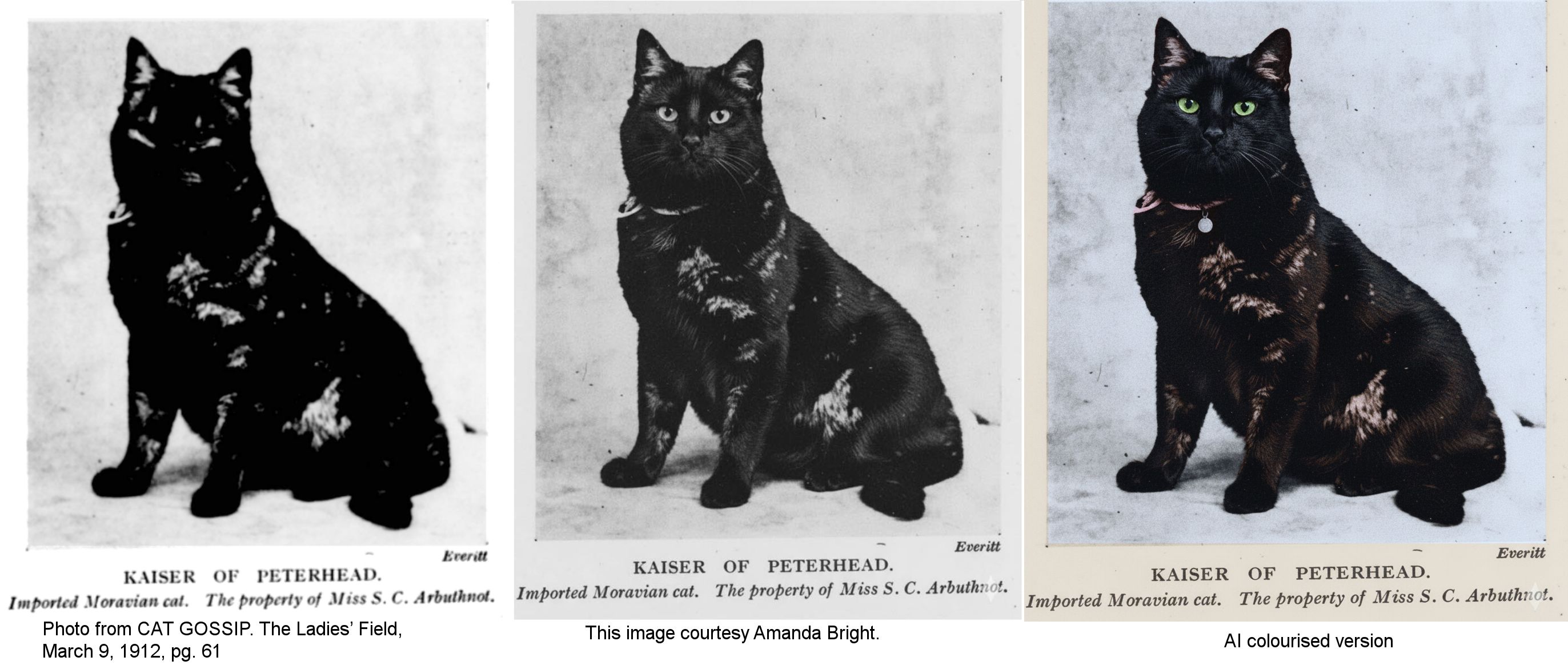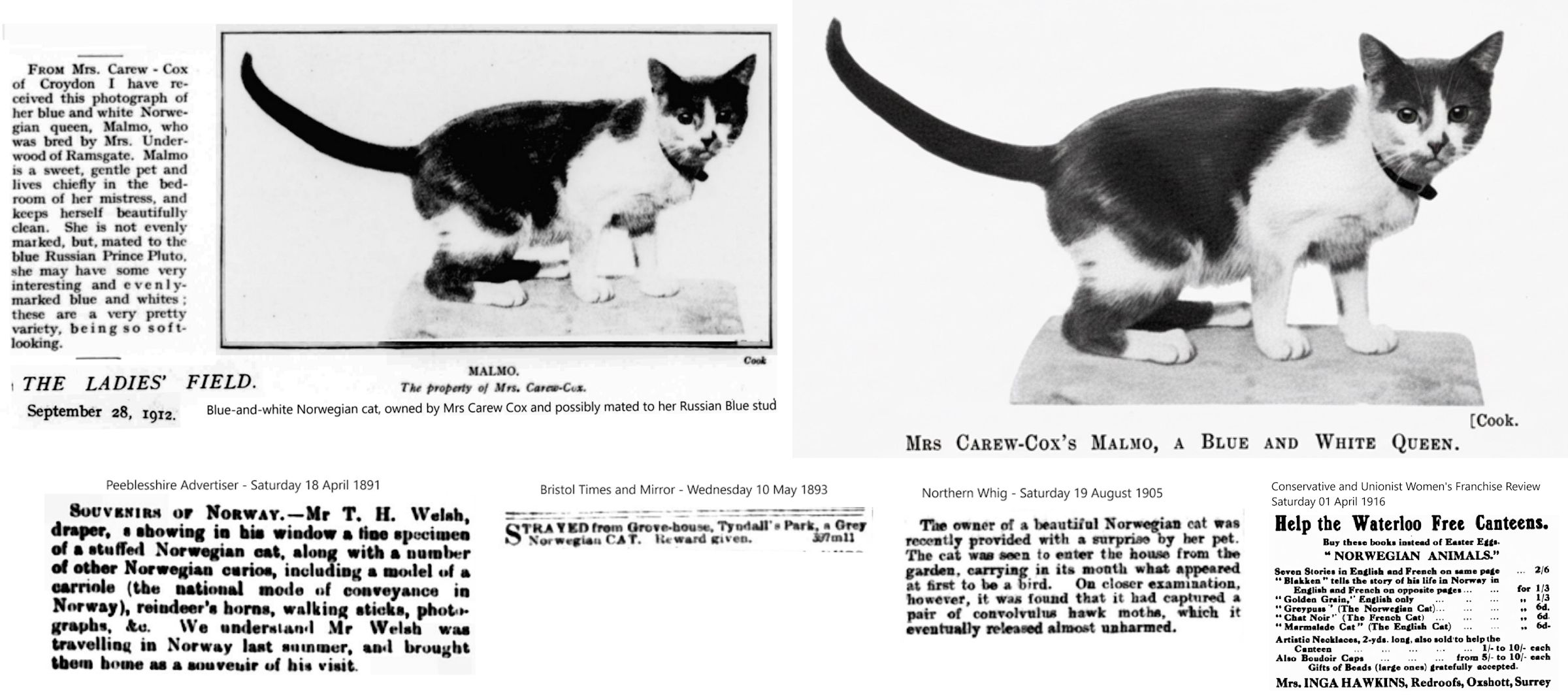
LOST BREEDS - BURMESE (1900) to SWISS ANGORA
While the Victorian and Edwardian exhibitor would be astounded (or even horrified) at the variety of breeds and colours on the modern show-bench, what about the breeds we missed? A number of unusual breeds are mentioned in early cat fancy literature. Some failed to attract sufficient interest from early cat fanciers. Others were based on hearsay and travellers tales and may never have existed in the form reported in early cat literature. Yet others were cases of mistaken identity (The Madagascar cat) or were mutations that were not perpetuated. Some of these "lost breeds" are known today by a different name although the early descriptions make it difficult to be certain. And yet other varieties, such as the British Tick, were absorbed into breeds that existed at the time.
One of the more amusing cases of mistaken identity was that of the "Madagascar Cat" which won the Foreign class at Crystal Palace (around 1900), but which turned out to be a Ringtailed Lemur. At the time, sailors sometimes brought back tame lemurs and called these little primates Madagascar Cats. The farce was reported in general newspapers as well as in the cat magazines of the time - surely a cat judge could tell the difference between a cat and a fruit-eating primate? Defending the decision, the judge (Miss H Cochran) reportedly stated "A lemur is a lemur, but a Madagascar cat is a Madagascar cat". A number of hybrids were also reported, including ones now known to be impossible such as the Civet/Cat hybrid and the Marten/Cat hybrid (the Civet referred to the Viverrine Civet, although the name has sometimes been used for the African Wildcat). There was also ongoing debate about the origins of the Siamese cats, with some enthusiasts insisting that it was descended from a cross between the Bay Cat and a viverrine. There were even early reports of Leopard Cat hybrids, decades before the Bengal was bred.
Although livestock breeders understood how to "fix" mutations by crossing to a more common type and then back-crossing the offspring to the mutant parent, cat fanciers seemed to hold out in the hope of finding a mate of the same type. The most famous loss was probably the original Mexican Hairless Cat, a breed that could have been saved. It would be some 60 years, and several missed opportunities, before the hairless type was re-established. Although we associate Peke-faced cats with the American Peke-faced Red Persian of the 1980s, a similar mutation was reported much earlier.
Lemurs and civets notwithstanding, imagine what might be on the modern show-bench had the following varieties attracted enough serious interest!
BURMESE (1900s STYLE)

The "Burmese" cat, which appeared in this photograph in Frances Simpson's 1903 "Book of the Cat", appears to be an Oriental ticked tabby, rather than the breed known today as the Burmese. Golden-eyed brown Temple cats from Thailand were described alongside the blue-eyed, seal-point "Royal Siamese," Simpson's book also described yellow-eyed brown Siamese cats, but were apparently not sufficiently interesting to the early cat fancier and the type was lost. They were probably forerunners of the modern Havanas, Burmese or Tonkinese - these modern breeds are western refinements of multiple naturally occurring varieties imported from Thailand in the late 1800s and early 1900s. The type depicted here is probably represented by the modern Oriental.
CANON GIRDLESTONE'S BREED / NORWEGIAN BLUE
The East & South Devon Advertiser, 20th October 1883, writes "The fifteenth National Cat Show at the Crystal Palace presented an interesting collection of feline pets. [...] Mrs. Carl Brook exhibited two pure-bred Norwegian kittens, bluish-black in colour, three months old 'Punch and Judy' by name."
Mrs Carew-Cox, an early breeder of Russian Blues, noted that short-haired blues existed in the north of Norway, in Iceland and in some parts of the US. "Many years ago, some blues (with faint tabby markings) were imported from the north of Norway; these were called 'Canon Girdlestone's breed'. I owned two very pretty soft-looking creatures." and also "In 1890 I owned a very pretty soft-looking blue female - she was, in fact, a blue tabby (one of Canon Girdlestone's breed); also a male of the same variety. They had evidently been victims of tapeworm for a cnsiderable period, and finally succumbed owing to the presence of these odious parasites in overwhelming numbers."
CHINESE MIBI CAT & HINDUSTANI INDIAN CAT
The Buffalo Review, 30th September 1899: Sara Jeannette Duncan is very fond of cats. When she was in Japan she purchased the best specimens the country afforded, and while in China a Mandarin presented her with a famous pink Mibi cat which does almost everything: but sing. The author has also an Indian cat which she secured in Hindustan; this is a great favorite at the Royal cat shows in England. Her friends, however, were not prepared for the following item which appeared in a society journal: Mrs. E. S. Coates' (Sara Jeanette Duncan’s) Indian cat is spending a few days with the Princess of Wales. Later she will be the guest of the Duchess of York and the Duchess of Marlborough. In reality, the cat was merely an inmate of an exhibition or a "cattery," but on the face of it the item was very imposing.
CYPRUS CAT

In 1896, Jean Bungartz wrote is his "Illustrated Book of Cats" (in German only): The Cyprus cat is yellow grey with black stripes and appears to have been carefully bred on the island of Cyprus. Michel Villamont wrote of the Cap della Gatte (cat cape) on Cyprus where a monastery was destroyed by the Turks and where there were cats that very effectively made war on the large numbers of snakes. Michel said of the snakes "they are long, black and white and around 6-8 inches thick on this island and are hunted and killed by the monastery cats. At noon the monastery bell calls these bold hunters to the meal, but as soon as they finish their food they resume anew their pursuit of their enemies."
In all probability the Cyprus cat was kept and bred in its original colouring and form. But not all yellow-grey, black cats are genuine Cyprus cats, unless their ancestors come from this island.
A blue or grey cat was described by HC Brooke (writing in 1927) as being found almost exclusively on the Isle of Cyprus. The fur was short and light grey. The paw pads were black and the ears were short and erect.
EGYPTIAN CAT
At the Kentish Town show in 1927, Mrs J H Richardson showed a huge (16.5 lbs) black and white cat "from the burning sands of Africa". This apparently caused quite a stir at the show. The cat had been imported from Egypt in 1925 and was entered in the short-hair neuter class at Kentish Town in 1927. As far as she knew he was the only specimen of his type in Britain (and being a neuter he was destined to remain so!). The type to which the cat belonged were the half-wild cats found near Bedouin encampments or on the outskirts of civilisation. They were largely nocturnal, hiding in the daytime and hunting or scavenging at night. In conformation the cats were large, very powerful, long-legged and had short necks. The small ears were set wide apart on a broad square-looking head. The eyes were rather oblique and generally wide open, "blazing contempt and defiance at their many enemies". Mrs Richardson explained that this breed was in no way related to the real Egyptian - or Caffre - cat.
Mrs Richardson found her cat near a Bedouin encampment outside Alexandria. He was skinny, ugly, half-grown and had a string-like tail. Armed with thick riding gloves, she caught the cat and set out to tame him. At first he remained wild, but at the end of a fortnight, he would eat meat from her hand. When he was tame and she allowed him his freedom, he did not roam away and became very devoted to his owner. Fed on raw meat and water he grew in size, but not in beauty and many people said he was hideous. He had short hair, a "hopeless irregular" black and white coat and a black patch covering one eye.
On the journey to England, he was allowed his freedom in hotels, ships and trains and he was well-behaved on these occasions, returning to his mistress and frequently spending the time asleep once he had explored his surroundings. While living at Norfolk he did good duty as a ratter, but during a stay in Hampshire he poached small rabbits and baby chickens. While in Hampshire he had to be tied up on a 20 ft string to prevent him poaching. He apparently bore this with good grace. In his next home he enjoyed complete freedom though he rarely wandered far afield. He also enjoyed evening walks with his mistress - often as much as five miles!
GREY CAT
Brian Vesey-Fitzgerald "Cats" (1958) mentioned that there were many other varieties of short-haired cats, some of which occasionally appear in the 'Any Other Variety' classes at the big shows. He wrote that "the Grey Cat (the Grimalkin of folk-lore) does not seem to occur in Britain, for some inexplicable reason, and only very occasionally in the United States (and there apparently only in the states of New England) whereas it is by no means uncommon on the Spanish side of the Pyrenees. The Grey Cat is a striped tabby from which the stripes have altogether disappeared except for two broad bands on the forelegs and a black tip to the tail. Since this is the true cat of witchcraft, it would seem that it must once have been much more widespread than it is to-day." This Grey Cat sounds like Canon Girdlestone's Breed.
HIMALAYAN CAT
Today, Himalayan refers to a colourpoint Persian, but huge, strong, blue-eyed pure white longhaired Himalayan cats were found in the high forest regions of Northern India, bordering Tibet, by English travellers. Its ancestry supposedly dated back thousands of years. Some of those pure white Himalayans were imported to Europe and were exhibited in London by Mrs McLaren Morrison (who seemed to collect all sorts of obscure varieties). Unfortunately most died, apparently due to homesickness or the British climate, and left no purebred offspring. Himalayan males were used to improve the eye colour and coat texture in white longhairs. (Van Gink Katten: Verzorging, teelt en rassen )
MAGPIE CAT
Brian Vesey-Fitzgerald "Cats" (1958) mentioned that there were many other varieties of short-haired cats, some of which occasionally appear in the 'Any Other Variety' classes at the big shows. The Magpie is described as a b1ack-and-white cat marked like a Dutch rabbit and "seems now entirely to have disappeared - a great pity for it was a fascinating creature to look at."
MALAYAN BLUE
According to "Cat Gossip" of 21 November 1928, the Toronto Cat Show Catalogue contained several classes unamiliar to British cat fanciers. One was for the Malayan Blue, One entry was registered, but it was absent from the show. The name could have applied either to the Korat or a solid blue "Siamese." The clipping refers to a small jungle cat, but also ties the name Malay[an] Self Blue to the Korat.

MOMBASSA CAT
In Frances Simpson's "Book of the Cat", Mr H C Brooke described the Mombassa cat: "A cat called the Mombassa cat, from the East of Africa, is said to have a short coat of wiry texture." In 1926, Brooke attempted to find out more about the Mombassa cat through discussion with wildlife photographer Mr Cherry Kearton and his wife, South African singer Ada Forrest. The wire-haired Mombassa cat had been referred to in old Natural History works, but the Keartons could not remember seeing any domestic cats in Mombassa. Brooke therefore dismissed the Mombassa cat as the work of imaginative or gullible writers.
The Mombassa cat may have been an isolated mutation or a traveller's tale. The general type would appear to be represented today by the American Wirehair or one of Rex breeds.
MOOR-HEADED CAT

In 1896, Jean Bungartz wrote is his "Illustrated Book of Cats": The black-headed or Mohrenkopf (Moorish-headed) cat must be clean white, with contrasting colour on the head and tail. Consistent specimens of this variety are extremely rare and it can probably be regarded as one of the most peculiar colour patterns of the domestic cat. The colour of the head and tail can be either black, grey, blue or yellow with no white hairs except those regularly showing up on the head. A previously mentioned, cats with good and correct markings are highly valued.
MORAVIAN CAT

This was described in the "Cat Gossip" column of The Ladies' Field, January 27, 1912, pg. 354. A photo appeared in The Ladies' Field, March 9, 1912, pg. 61
"MISS ARBURTHNOT of Upper Norwood is the possessor of a Moravian cat, which she thinks is the only one of his breed in England; he rejoices in the name of Kaiser of Peterhead. This cat is very handsome, being dark grey with black points; he has a thick, close coat, and if the fur is blown the wrong way the undergrowth is almost white. He is very affectionate and licks the hand like a dog, but if angry he bites, though he does not scratch. He is only a year old, and promises to be a large and heavy cat. Kaiser of Peterhead was on exhibition at the Crystal Palace, but, unfortunately, his pen was in such a bad light that no one could see him."
From the description it seems likely that this was a black smoke shorthair, a variety not bred in Britain at that time. Black smoke Persians were bred and black smoke shorthairs would have appeared when silver tabby shorthairs were bred to self black shorthairs in an attempt to intensify the markings, but the kittens would have been dismissed as unsound black shorthairs and most likely destroyed by breeders. When a black smoke cat was imported from overseas, however, it excited interest!
NORWEGIAN CAT

From Mrs. Carew-Cox of Croydon I have received this photograph of her blue and white Norwegian queen, Malmo, who was bred by Mrs. Underwood of Ramsgate. Malmo is a sweet, gentle pet and lives chiefly in the bedroom of her mistress, and keeps herself beautifully clean. She is not evenly marked, but, mated to the blue Russian Prince Pluto, she may have some very interesting and evenly-marked blue and whites; these are a very pretty variety, being so soft-looking. (CAT GOSSIP. The Ladies' Field, September 28, 1912, pg. 210)
In Norway is to be found a very pretty variety, the blue and white cat. They are close-coated and remarkably neat, with a white splash up the nose, white chest, and four white paws. This is a peculiarly fascinating breed, the evenly-marked white against the blue being most effective. The only one I know of in this country is Mrs Carew-Cox's Malmo, a very large queen, but as she is not evenly marked she has never been shown. Norway can also claim shorthaired blues of the Russian type. (CAT NEWS AND NOTES The Queen, 25 September 1915)
This was an ordinary blue-and-white domestic cat from Norway, but it was considered exotic in Britain.
PARAGUAY CAT
This was described as being a quarter smaller than a domestic cat, though some newspapers printed it as "a quarter the size of a domestic cat," which would have been an extremely small cat! According to the Nottingham Evening Post, 29th October, 1902, There is a record entry at the National Cat Club annual exhibition now looked on as the representative fixture of the year, which opened yesterday at the Crystal Palace. The novelty of the show is the Paraguay cat exhibited by Mrs. H.C. Brooke. It won first prize in a section for foreign cats of any variety.
So, what was this Paraguay cat? It's most likely to be a wild cat, since the Brooke's had a penchant for wild species, some of which they crossed to domestic cats. In "Cat Gossip" Brooke wrote about possible crosses that would produce a truly spotted cat. The Ocelot and Eyra (Jaguarundi) were already known by name. Margays were considered to be a variety of Ocelot. Other candidate cats that are present in Paraguay are Geoffroy s Cat, Oncilla and the Colocolo/Pampas Cat.
SHORT-HAIRED PERSIAN
In 1926, Cat Gossip editor H C Brooke noted that at a cat show in Lille there were classes for "Short-hair Persians" (chats persans a poil ras) as well as the normal Long-hair classes. Brooke wondered how "Short-hair Persians" were distinguished from ordinary Short-hairs. In those days, the Persian had not yet become the flat-faced creature we see today and might have been termed a "British Longhair".
The "Short-haired Persian" of the 1920s would have been similar to the British Short-hair of that time. Today, the Persian conformation has changed so greatly that the short-haired form is represented by the Exotic Shorthair. In fact it turns out that the Shorthair Persian meant "British Blue Shorthair." In Tier-Boerse magazine (sometime in the 1920s), Professor Sehwangart wrote as follows: As far back as the eighties the English Fancy decided of the several hitherto recognised varieties of L.H. only to admit the Persian form; France followed their example last year. Breed qualifications were denied the Angora, and doubtless rightly so. What are shown under this name are mostly badly bred Persians, or else the Blues are called Persians, the other coloured L.H. cats Angoras, and the characteristics of the Persian are misunderstood, this misunderstanding going so far that S.H. Blues have been described as S.H. Persians.
SWISS ANGORA
The term "Angora" meant "longhair" in the late 19th and early 20th centuries. This photo and its caption are from the 1902 "Cat Manual" by "Dick Whittington." It may have been ancestor of the modern German Longhair/German Angora breeds.
